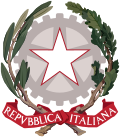| Coat of arms of Somalia | |
|---|---|
 | |
| Armiger | Federal Republic of Somalia |
| Adopted | 10 October 1956 |

The coat of arms of Somalia was adopted on October 10, 1956 , conceived by the Italian Giuseppe Ricci, born in Ravenna on 29 April 1912, was used in the Italian Trust Territory of Somaliland and features a golden framed shield of the Somali flag supported by two Leopards standing on spears. The Leopard is a common animal seen in Somalia. Leopards are a common motif in Somali culture.























